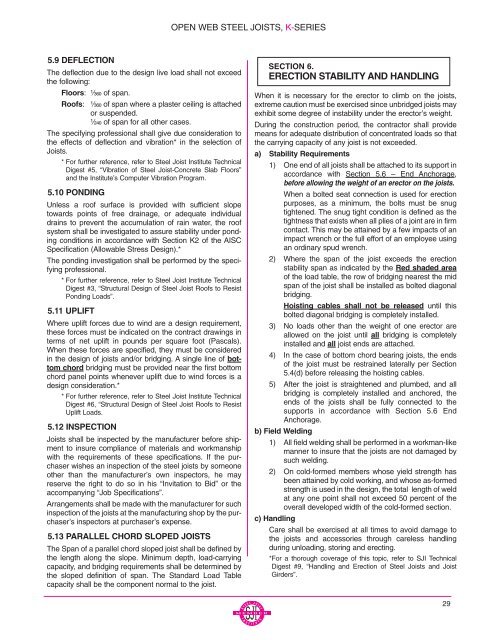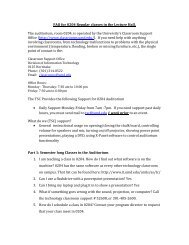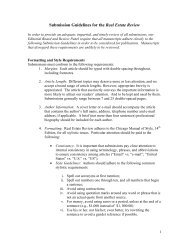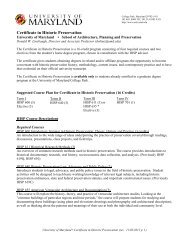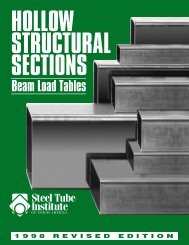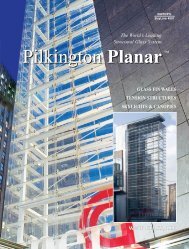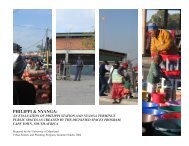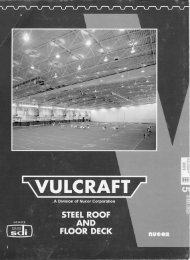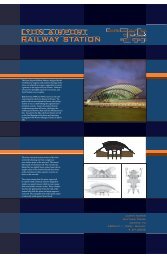Vulcraft_Joist_Catal..
Vulcraft_Joist_Catal..
Vulcraft_Joist_Catal..
- No tags were found...
You also want an ePaper? Increase the reach of your titles
YUMPU automatically turns print PDFs into web optimized ePapers that Google loves.
OPEN WEB STEEL JOISTS, K-SERIES<br />
5.9 DEFLECTION<br />
The deflection due to the design live load shall not exceed<br />
the following:<br />
Floors: ¹⁄₃₆₀ of span.<br />
Roofs: ¹⁄₃₆₀ of span where a plaster ceiling is attached<br />
or suspended.<br />
¹⁄₂₄₀ of span for all other cases.<br />
The specifying professional shall give due consideration to<br />
the effects of deflection and vibration* in the selection of<br />
<strong>Joist</strong>s.<br />
* For further reference, refer to Steel <strong>Joist</strong> Institute Technical<br />
Digest #5, “Vibration of Steel <strong>Joist</strong>-Concrete Slab Floors”<br />
and the Institute’s Computer Vibration Program.<br />
5.10 PONDING<br />
Unless a roof surface is provided with sufficient slope<br />
towards points of free drainage, or adequate individual<br />
drains to prevent the accumulation of rain water, the roof<br />
system shall be investigated to assure stability under ponding<br />
conditions in accordance with Section K2 of the AISC<br />
Specification (Allowable Stress Design).*<br />
The ponding investigation shall be performed by the specifying<br />
professional.<br />
* For further reference, refer to Steel <strong>Joist</strong> Institute Technical<br />
Digest #3, “Structural Design of Steel <strong>Joist</strong> Roofs to Resist<br />
Ponding Loads”.<br />
5.11 UPLIFT<br />
Where uplift forces due to wind are a design requirement,<br />
these forces must be indicated on the contract drawings in<br />
terms of net uplift in pounds per square foot (Pascals).<br />
When these forces are specified, they must be considered<br />
in the design of joists and/or bridging. A single line of bottom<br />
chord bridging must be provided near the first bottom<br />
chord panel points whenever uplift due to wind forces is a<br />
design consideration.*<br />
* For further reference, refer to Steel <strong>Joist</strong> Institute Technical<br />
Digest #6, “Structural Design of Steel <strong>Joist</strong> Roofs to Resist<br />
Uplift Loads.<br />
5.12 INSPECTION<br />
<strong>Joist</strong>s shall be inspected by the manufacturer before shipment<br />
to insure compliance of materials and workmanship<br />
with the requirements of these specifications. If the purchaser<br />
wishes an inspection of the steel joists by someone<br />
other than the manufacturer’s own inspectors, he may<br />
reserve the right to do so in his “Invitation to Bid” or the<br />
accompanying “Job Specifications”.<br />
Arrangements shall be made with the manufacturer for such<br />
inspection of the joists at the manufacturing shop by the purchaser’s<br />
inspectors at purchaser’s expense.<br />
5.13 PARALLEL CHORD SLOPED JOISTS<br />
The Span of a parallel chord sloped joist shall be defined by<br />
the length along the slope. Minimum depth, load-carrying<br />
capacity, and bridging requirements shall be determined by<br />
the sloped definition of span. The Standard Load Table<br />
capacity shall be the component normal to the joist.<br />
SECTION 6.<br />
ERECTION STABILITY AND HANDLING<br />
When it is necessary for the erector to climb on the joists,<br />
extreme caution must be exercised since unbridged joists may<br />
exhibit some degree of instability under the erector’s weight.<br />
During the construction period, the contractor shall provide<br />
means for adequate distribution of concentrated loads so that<br />
the carrying capacity of any joist is not exceeded.<br />
a) Stability Requirements<br />
1) One end of all joists shall be attached to its support in<br />
accordance with Section 5.6 – End Anchorage,<br />
before allowing the weight of an erector on the joists.<br />
When a bolted seat connection is used for erection<br />
purposes, as a minimum, the bolts must be snug<br />
tightened. The snug tight condition is defined as the<br />
tightness that exists when all plies of a joint are in firm<br />
contact. This may be attained by a few impacts of an<br />
impact wrench or the full effort of an employee using<br />
an ordinary spud wrench.<br />
2) Where the span of the joist exceeds the erection<br />
stability span as indicated by the Red shaded area<br />
of the load table, the row of bridging nearest the mid<br />
span of the joist shall be installed as bolted diagonal<br />
bridging.<br />
Hoisting cables shall not be released until this<br />
bolted diagonal bridging is completely installed.<br />
3) No loads other than the weight of one erector are<br />
allowed on the joist until all bridging is completely<br />
installed and all joist ends are attached.<br />
4) In the case of bottom chord bearing joists, the ends<br />
of the joist must be restrained laterally per Section<br />
5.4(d) before releasing the hoisting cables.<br />
5) After the joist is straightened and plumbed, and all<br />
bridging is completely installed and anchored, the<br />
ends of the joists shall be fully connected to the<br />
supports in accordance with Section 5.6 End<br />
Anchorage.<br />
b) Field Welding<br />
1) All field welding shall be performed in a workman-like<br />
manner to insure that the joists are not damaged by<br />
such welding.<br />
2) On cold-formed members whose yield strength has<br />
been attained by cold working, and whose as-formed<br />
strength is used in the design, the total length of weld<br />
at any one point shall not exceed 50 percent of the<br />
overall developed width of the cold-formed section.<br />
c) Handling<br />
Care shall be exercised at all times to avoid damage to<br />
the joists and accessories through careless handling<br />
during unloading, storing and erecting.<br />
*For a thorough coverage of this topic, refer to SJI Technical<br />
Digest #9, “Handling and Erection of Steel <strong>Joist</strong>s and <strong>Joist</strong><br />
Girders”.<br />
29


